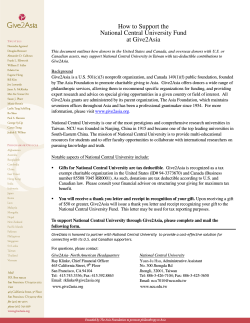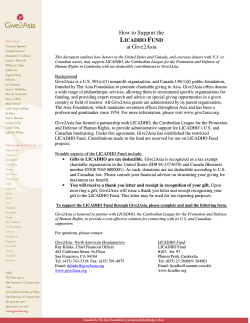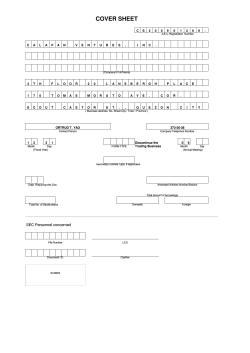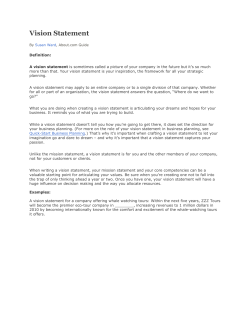
CORPORATE FINANCE Laurence Booth • W. Sean Cleary INTRODUCTION TO Ken Hartviksen
INTRODUCTION TO CORPORATE FINANCE Laurence Booth • W. Sean Cleary Prepared by Ken Hartviksen CHAPTER 1 An Introduction to Finance Lecture Agenda • • • • • • • • Learning Objectives Important Terms Finance Defined Real versus Financial Assets The Financial System Financial Instruments and Markets The Global Financial Community Summary and Conclusions – Concept Review Questions CHAPTER 1 - An Introduction to Finance 1-3 Learning Objectives 1. 2. 3. 4. 5. 6. What finance is and what is involved in the study of finance. How financial securities can be used to provide financing for borrowers and simultaneously to provide investment opportunities for lenders. How financial systems work in general. The channels of intermediation and the role played by market and financial intermediaries within this system. The basic types of financial instruments that are available and how they are traded. The importance of the global financial system. CHAPTER 1 - An Introduction to Finance 1-4 Key Terms • • • • • • • • • • • • • • • • • Bourse de Montréal brokers Canadian Trading and Quotation System Inc. (CNQ) capital market securities common share corporate finance Crown corporations dealer or over-the-counter (OTC) markets debt instruments equity instruments exchanges or auction markets finance financial assets financial intermediaries fourth market intermediation investments CHAPTER 1 - An Introduction to Finance 1-5 Key Terms • • • • • • • • • • • • • • • • • market capitalization market intermediary marketable financial assets money market securities New York Stock Exchange (NYSE) non-marketable financial assets Ontario Securities Commission preferred shares primary markets real assets secondary markets third market Toronto Stock Exchange (TSX) TSX Group Inc. TSX Markets TSX Venture Exchange Winnipeg Commodity Exchange CHAPTER 1 - An Introduction to Finance 1-6 What Is Finance? • Finance is the study of how and under what terms savings (money) are allocated between lenders and borrowers. – Finance is distinct from economics in that it addresses not only how resources are allocated but also under what terms and through what channels • Financial contracts or securities occur whenever funds are transferred from issuer to buyer. CHAPTER 1 - An Introduction to Finance 1-7 The Study of Finance • The study of finance requires a basic understanding of: – Securities – Corporate law – Financial institutions and markets CHAPTER 1 - An Introduction to Finance 1-8 Real Versus Financial Assets • Real assets are tangible things owned by persons and businesses – – – – Residential structures and property Major appliances and automobiles Office towers, factories, mines Machinery and equipment • Financial assets are what one individual has lent to another – Consumer credit – Loans – Mortgages CHAPTER 1 - An Introduction to Finance 1-9 Assets and Liabilities of Households, 2005 Table 1-2 Assets and Liabilities of Households, 2005 Assets $ Billion Houses 1,086 Consumer Durables 435 Land 827 Real Assets 2,348 Deposits 683 Debt 114 Pensions and insurance 1,200 Shares 1,254 Foreign and other 72 Financial Assets 3323 Total Assets 5,671 Liabilities $ Billion Consumer credit 260 Loans 131 Mortgages 588 Total Liabilities 979 So urce: Statistics Canada. Natio nal B alance Sheet A cco unts, Quarterly Estimates, Fo urth Quarter 2005. Ottawa: M inister o f Industry, 2006 (Catalo gue No . 13-214-XIE). CHAPTER 1 - An Introduction to Finance 1 - 10 The Financial System Overview • The household is the primary provider of funds to businesses and government. • Households must accumulate financial resources throughout their working life times to have enough savings (pension) to live on in their retirement years • Financial intermediaries transform the nature of the securities they issue and invest in • Banks, trust companies, credit unions, insurance firms, mutual funds • Market intermediaries simply help make markets work • Investment dealers • Brokers CHAPTER 1 - An Introduction to Finance 1 - 11 The Financial System FIGURE 1-2 CHAPTER 1 - An Introduction to Finance 1 - 12 The Financial System Channels of Intermediation • Funds can be channeled from saver to borrower in three ways: – Direct intermediation (direct transfer from saver to borrower – a non-market transaction) – Direct intermediation (a market-based transaction usually through a market intermediary such as a broker) – Indirect claims through a financial intermediary (where the financial intermediary such as a bank offers deposit-taking services and ultimately lends those deposits out as mortgages or loans) CHAPTER 1 - An Introduction to Finance 1 - 13 Channels of Intermediation FIGURE 1-3 CHAPTER 1 - An Introduction to Finance 1 - 14 The Financial System Financial Intermediaries • • • • Banks and other deposit-taking institutions Insurance companies Pension Funds Mutual Funds CHAPTER 1 - An Introduction to Finance 1 - 15 Financial Intermediaries Canadian Chartered Banks • • • • Banks take deposits from numerous depositors from across Canada The deposits are ‘pooled’ in the Bank The bank takes these pooled funds and lends them out to households and businesses in the form of mortgages and loans The bank transforms the original nature of the savers (depositors) money: – Deposits are usually small in amount…face little or no risk, and depositors expect to withdraw the amount at any time – Loans and mortgages on the other hand usually have the following characteristics: • Large sums • Borrowed for long periods of time • Borrowed for risky purposes. • Banks can perform this transformation function because they become experts at risk assessment, financial contracting (pricing the risk) and monitoring the activities of borrowers. CHAPTER 1 - An Introduction to Finance 1 - 16 Financial Intermediaries Canadian Chartered Banks Table 1-3 Chartered Banks: Financial Statistics, 2005 Bank Royal Bank of Canada Canadian Imperial Bank of Commerce (CIBC) Bank of Nova Scotia TD Canada Trust Bank of Montreal National Bank Revenue Assets Profits ($ million) ($ million) ($ million) 29,403 469,521 3,387 18,677 18,332 18,665 15,138 5,320 280,370 314,025 365,210 297,532 107,598 -32 3,209 2,229 2,400 855 So urce: B M O Investo rLine website: www.bmo investo rline.co m, Octo ber 31, 2006. CHAPTER 1 - An Introduction to Finance 1 - 17 Financial Intermediaries Insurance Companies – Insurers sell policies and collect premiums from customers based on the pricing of those policies given the probability of a claim and the size the policy and administrative fees. – They invest the premiums so that the accumulated value in the future will grow to meet the anticipated claims of the policyholders. – In this way, unsupportable risks (such as the death of wage earner or the burning down of a business) are shared among a large number of policyholders through the insurance company. – Insurance allows households, business and government to engage in risky activities without having to bear the entire risk of loss themselves. CHAPTER 1 - An Introduction to Finance 1 - 18 Financial Intermediaries Insurance Companies Table 1-4 Insurance Companies: Financial Statistics, 2005 Insurer Manulife Financial Sun Life Financial Great-West Lifeco ING Canada Revenue Assets Profits ($ million) ($ million) ($ million) 32,187 322,171 3,294 21,871 171,850 1,867 23,883 102,161 1,775 4,446 9,926 782 So urce: Data fro m B M O Investo rLine website: www.bmo investo rline.co m, Octo ber 31, 2006. CHAPTER 1 - An Introduction to Finance 1 - 19 Financial Intermediaries Pension Plan Assets – Individuals and employers make payments over the entire working life of a person with those funds invested to grow over time. – Ultimately, the accumulated value in the pension can be used by the person in retirement. – Pension plans accumulate considerable sums of money, and their managers invest those funds with long-term investment time horizons in diversified portfolios of investments. These investments are a major source of capital, fuelling investment in research and development, capital equipment, resource exploration and ultimately contributing in a substantial way to growth in the economy. CHAPTER 1 - An Introduction to Finance 1 - 20 Financial Intermediaries Pension Plan Assets Table 1-5 Pension Plan Assets, 2005 Pension Plan Managers Caisse de depot et placement du Quebec Canada Pension Plan (CPP) Ontario Teachers (Teachers) Ontario Municipal Employees (OMERS) Net Assets ($ billion) 216.1 98.0 96.1 41.6 * The Caisse manages the investments o f several pensio n plans. CHAPTER 1 - An Introduction to Finance 1 - 21 Financial Intermediaries Canadian Mutual Fund Assets • Mutual funds give small investors access to diversified, professionally-managed portfolios of securities. • Small investors often do not have the funds necessary to invest directly into market-traded stocks and bonds. • This is called denomination intermediation because the mutual fund makes investments available in smaller, more affordable amounts of money. • Canadian indirect investment in the markets through managed products such as mutual funds and segregated funds has grown exponentially. (see Figure 1-4 on the next slide) CHAPTER 1 - An Introduction to Finance 1 - 22 Financial Intermediaries Canadian Mutual Fund Assets FIGURE 1-4 CHAPTER 1 - An Introduction to Finance 1 - 23 The Financial System The Major Borrowers • Public Debt – Governments • • • • Federal Provincial Municipal Crown Corporations • Private Debt – Households – Non-financial Corporations CHAPTER 1 - An Introduction to Finance 1 - 24 The Financial System Largest Non-financial Companies Table 1-6 Non-Financial Canadian Companies: Financial Statistics, 2005 Non-financial Companies General Motors of Canada Ltd. Loblaw Companies Ltd. Magna International Inc. Imperial Oil Ltd. Alcan Inc.* BCE Inc. Bombardier Inc.* Petro-Canada Onex Corp. EnCana Corp.* Revenue Assets ($ million) ($ million) 34,991 n/a 27,812 13,761 22,873 12,321 26,936 15,582 20,408 26,638 19,150 40,630 14,882 17,483 17,673 20,655 17,626 14,845 14,322 34,148 *Co mpany repo rts in U.S. do llars. So urce: Data fro m "The To p 1000 in 2005." Glo be and M ail Repo rt o n B usiness website: www.theglo beandmail.co m. CHAPTER 1 - An Introduction to Finance 1 - 25 Financial Instruments • There are two major categories of financial securities: 1. Debt Instruments – – – – – – Commercial paper Bankers’ acceptances Treasury bills Mortgage loans Bonds Debentures 2. Equity Instruments – – Common stock Preferred stock CHAPTER 1 - An Introduction to Finance 1 - 26 Financial Instruments Non-marketable • Characteristics of non-marketable securities – Cannot be traded between or among investors – May be redeemable (a reverse transaction between the borrower and the lender) – Examples: • • • • Savings accounts Term Deposits Guaranteed Investment Certificates Canada Savings Bonds CHAPTER 1 - An Introduction to Finance 1 - 27 Financial Instruments Marketable • Characteristics of Marketable securities – • Can be traded between or among investors after their original issue in public markets and before they mature or expire Market Capitalization – – – Is an important term in finance It is the total market value of a company It is found by multiplying the number of shares outstanding by the market price per share. Market Capitaliza tion Number of shares Price per share CHAPTER 1 - An Introduction to Finance 1 - 28 Financial Instruments Marketable Markets can be categorized by the time to maturity: • Money Market Securities (for short-term debt securities that are pure discount notes) – Bankers’ acceptances – Commercial Paper – Treasury Bills • Capital Market Securities (for long-term debt or equity securities with maturities greater than 1 year) – – – – Bonds Debentures Common Stock Preferred Stock CHAPTER 1 - An Introduction to Finance 1 - 29 Financial Markets • Primary Market – Markets that involve the issue of new securities by the borrower in return for cash from investors (Capital formation occurs) • Secondary Market – Markets that involve buyers and sellers of existing securities. Funds flow from buyer to seller. Seller becomes the new owner of the security. (No capital formation occurs) CHAPTER 1 - An Introduction to Finance 1 - 30 Financial Markets Types of Secondary Markets • Exchanges or Auction Markets • Secondary markets that involve a bidding process that takes place in specific location • For example TSX, NYSE • Dealer or Over-the-counter (OTC) Markets • Secondary markets that do not have a physical location and consist of a network of dealers who trade directly with one another. • For example the bond market CHAPTER 1 - An Introduction to Finance 1 - 31 Financial Markets Other Markets • Third Market • Trading of securities that are listed on organized exchanges in the Over-the-counter market • Fourth Market • Trading of securities directly between investors (usually between two large institutions) without the involvement of brokers or dealers. • Operates through the use of privately owned automated systems such as Instinet CHAPTER 1 - An Introduction to Finance 1 - 32 The Global Financial Community • Represents an important source of funds for borrowers • Provides investors with important alternatives as they seek to build wealth through diversified portfolios CHAPTER 1 - An Introduction to Finance 1 - 33 The Global Financial Community Table 1-7 Canada's International Investments, 2005 Total Assets Canadian direct investments abroad Canadian portfolio investments Portfolio foreign bonds 82,374 Portfolio foreign stocks 189,175 Other portfolio investments 13,055 Other Canadian investments Loans 48,325 Allowances Deposits 120,694 Official international reserves 38,030 Other assets 59,319 Total Liabilities Foreign direct investments in Canada Foreign portfolio investments Portfolio Canadian bonds 380,017 Portfolio Canadian stocks 107,598 Portfolio Canadian money market instruments 20,783 Other foreign investments Loans 36,107 Deposits 201,639 Other liabilities 22,829 Canada's Net International Investment Position ($ million) 1,016,031 465,058 284,604 266,369 1,184,534 415,561 508,398 260,575 -168,503 So urce: Statistics Canada. CHAPTER 1 - An Introduction to Finance 1 - 34 Summary • In this chapter you have learned about: – Financial systems in general, and the Canadian financial system in particular – Major participants in the Canadian financial system, including the different types of financial securities and financial markets CHAPTER 1 - An Introduction to Finance 1 - 35 Internet Links • BMO InvestorLine: www.bmoinvestorline.com • Investment Funds Institute of Canada: www.ific.ca • Globe and Mail Report on Business: www.theglobeandmail.com • Toronto Stock Exchange (TSX): http://www.tsx.com/ • Canadian Trading and Quotation System Inc.: http://www.cnq.ca/ • Ontario Securities Commission: http://www.osc.gov.on.ca/index.jsp • Winnipeg Commodity Exchange: http://www.wce.ca/ • New York Stock Exchange (NYSE) Euronext: http://www.nyse.com/ CHAPTER 1 - An Introduction to Finance 1 - 36 Copyright Copyright © 2007 John Wiley & Sons Canada, Ltd. All rights reserved. Reproduction or translation of this work beyond that permitted by Access Copyright (the Canadian copyright licensing agency) is unlawful. Requests for further information should be addressed to the Permissions Department, John Wiley & Sons Canada, Ltd. The purchaser may make back-up copies for his or her own use only and not for distribution or resale. The author and the publisher assume no responsibility for errors, omissions, or damages caused by the use of these files or programs or from the use of the information contained herein. CHAPTER 1 - An Introduction to Finance 1 - 37
© Copyright 2025









